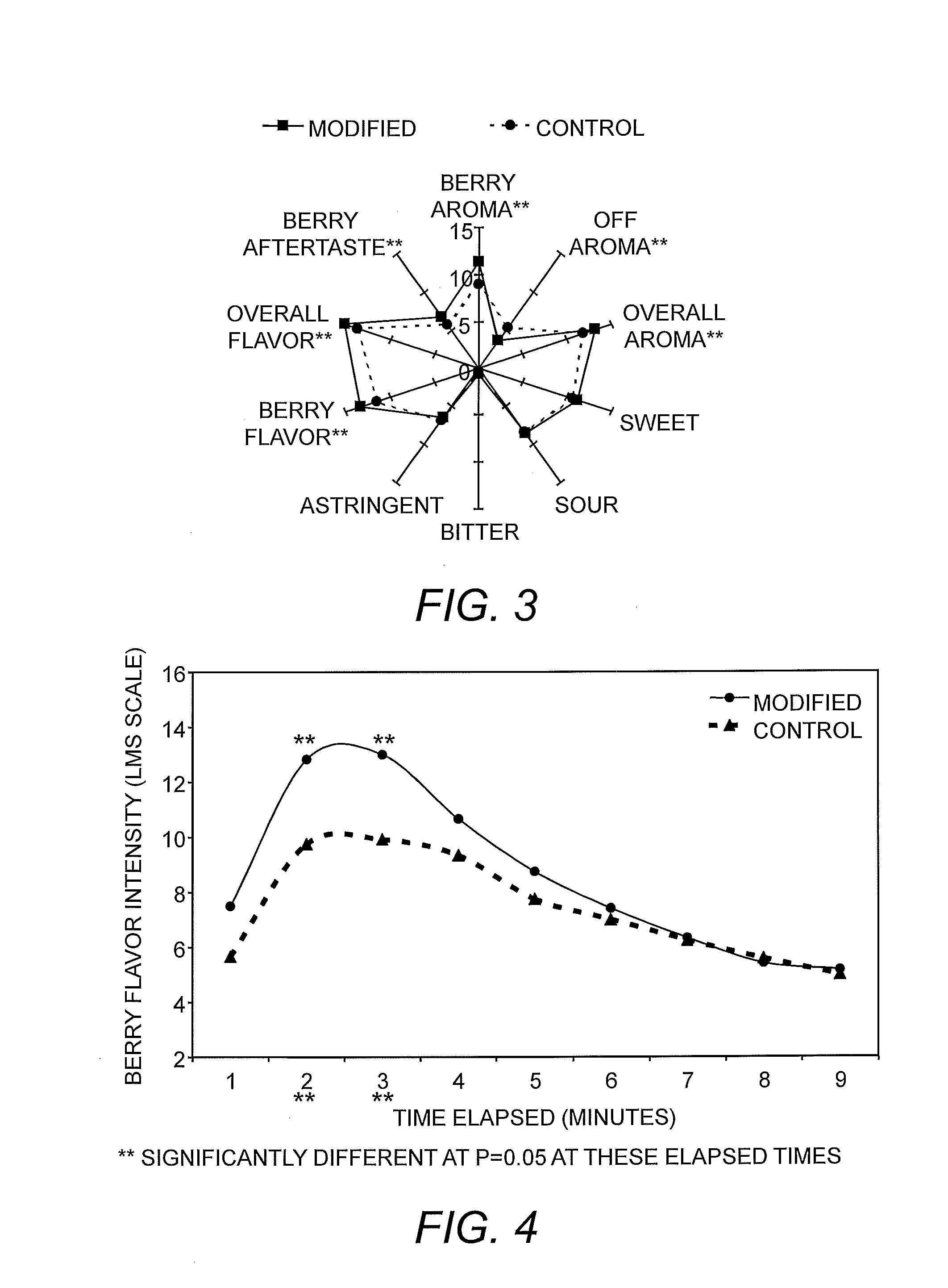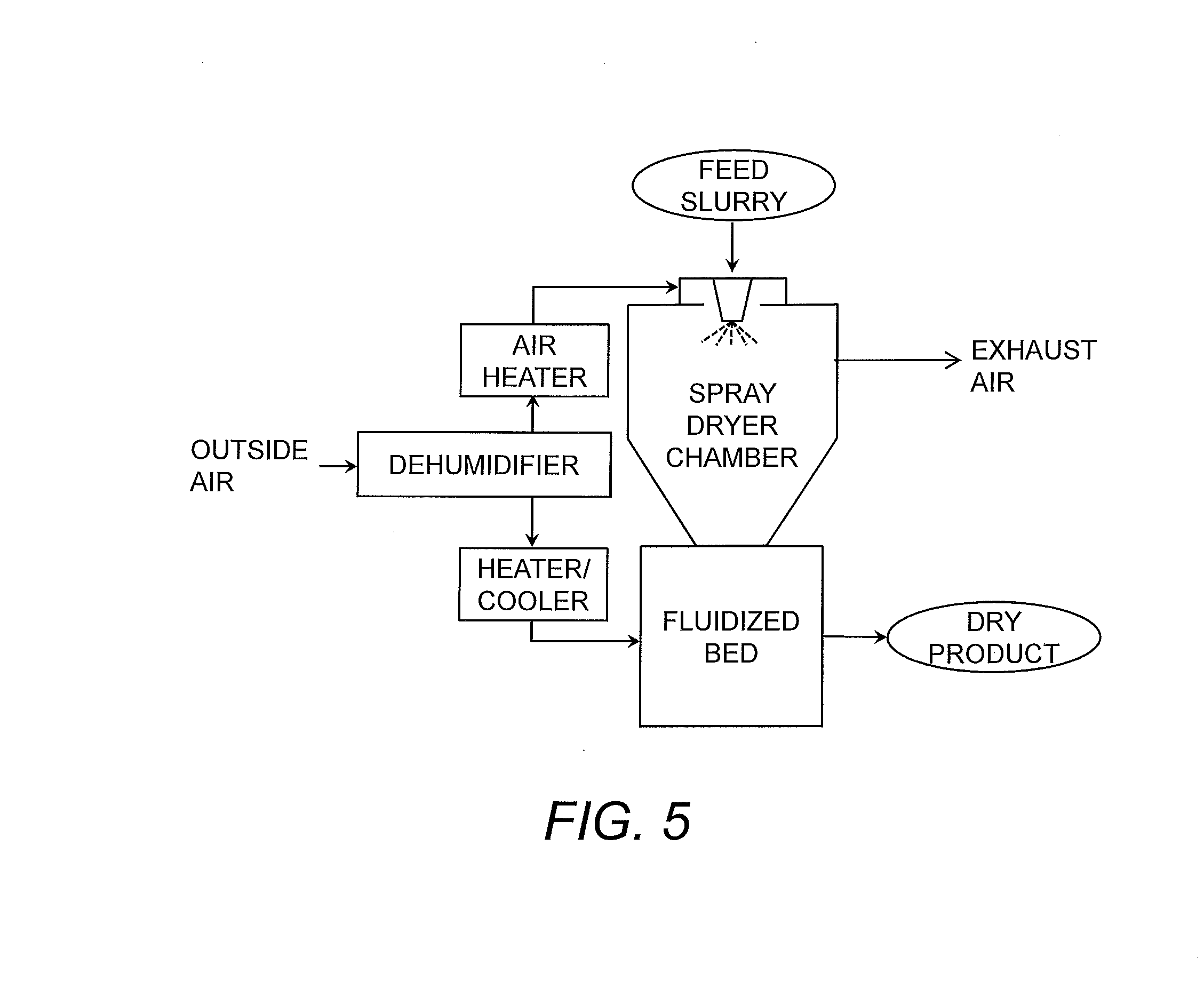Spray-Dried Compositions Capable of Retaining Volatile Compounds and Methods of Producing the Same
a technology of volatile compounds and spray-dried compositions, which is applied in the field of spray-dried compositions capable of retaining volatile compounds and methods of producing the same, can solve the problems of increasing process times and costs, affecting the flavor of raw materials, and generating dry powder with burned odor, etc., and achieves the effect of stable spray-dried flavor compositions
- Summary
- Abstract
- Description
- Claims
- Application Information
AI Technical Summary
Benefits of technology
Problems solved by technology
Method used
Image
Examples
example 1
Formulations for Dry Flavor Powders
[0042]A comparison between modified formulas and conventional control formulas was conducted. Exemplary Control and Modified formulas of dry flavor powders are listed in Table 2.
TABLE 2ComponentControlModifiedControlModifiedOrange Flavor20%16%Berry Flavor11%16%Modified starch10% 8%72% 8%Carbohydrates70%76%17%76%(e.g., sugar,corn syrup,maltodextrin)
[0043]Control powders were produced by a conventional process conditions and Modified powders were produced by the instant modified process (FIG. 5), according to the conditions listed in Table 3. In both cases, a conventional spray dryer without an integrated fluid-bed was used.
TABLE 3Spray Dryer OperatingParameterStandardModifiedInlet air temperature (° C.)170-210Inlet air humidity 2-180-4(g H2O / kg dry air)Outlet air temperature (° C.) 80-10035-55Outlet air humidity 45-5510-20(g H2O / kg dry air)Atomizer typeRotaryRotary Disc Discor Nozzle
[0044]All formulations ran well with minimal hold-up, sticking, or...
example 2
Retention of Volatile Compounds in Modified Orange Flavor Formulation
[0045]Using GC-FID (gas chromatography-flame ionization detector) analysis, the volatile profile of the Orange Flavor formulations in Example 1 was determined. This analysis indicated that the retention of specific volatile materials for the Modified powder compared to the level in the emulsion were approximately 72%, 75%, and 52% for ethyl propionate, ethyl butyrate, and acetaldehyde, respectively. Table 4 indicated the ratio of volatiles retained in the Modified powder in comparison to the Control powder. Sensory tests showed benefit of the Modified powder over the Control powder in a beverage tasting solution (significantly greater overall aroma and orange flavor; FIG. 1) and in chewing gum (significantly greater orange flavor intensity at the 30 and 60 second intervals; FIG. 2).
TABLE 4EthylEthylOrange FlavorPropionateButyrateAcetaldehydeModified2.31.61.8Control1.01.01.0
example 3
Retention of Volatile Compounds in Modified Berry Flavor Formulation
[0046]Using GC-FID analysis, the volatile profile of the Berry Flavor formulations in Example 1 was determined. This analysis indicated that the retention of specific volatile materials for the Modified powder compared to the level in the emulsion were approximately 24%, 35%, and 87% for dimethyl sulfide, ethyl acetate, and ethyl butyrate, respectively. Table 5 indicated the ratio of volatiles retained in the modified powder in comparison to the Control powder. Sensory tests showed benefit of the Modified powder over the Control powder in a beverage tasting solution (significantly greater berry aroma and flavor, among others; FIG. 3) and in chewing gum (significantly greater berry flavor intensity at the 30 and 60 second intervals; FIG. 4).
TABLE 5DimethylEthylEthylBerry FlavorSulfideAcetateButyrateModified12.713.44.5Control1.01.01.0
PUM
 Login to View More
Login to View More Abstract
Description
Claims
Application Information
 Login to View More
Login to View More - R&D
- Intellectual Property
- Life Sciences
- Materials
- Tech Scout
- Unparalleled Data Quality
- Higher Quality Content
- 60% Fewer Hallucinations
Browse by: Latest US Patents, China's latest patents, Technical Efficacy Thesaurus, Application Domain, Technology Topic, Popular Technical Reports.
© 2025 PatSnap. All rights reserved.Legal|Privacy policy|Modern Slavery Act Transparency Statement|Sitemap|About US| Contact US: help@patsnap.com



